Attached files
| file | filename |
|---|---|
| EX-99.1 - EX-99.1 - Avery Dennison Corp | a19-3645_1ex99d1.htm |
| 8-K - 8-K - Avery Dennison Corp | a19-3645_18k.htm |
Fourth Quarter and Full Year 2018 Financial Review and Analysis (preliminary, unaudited)
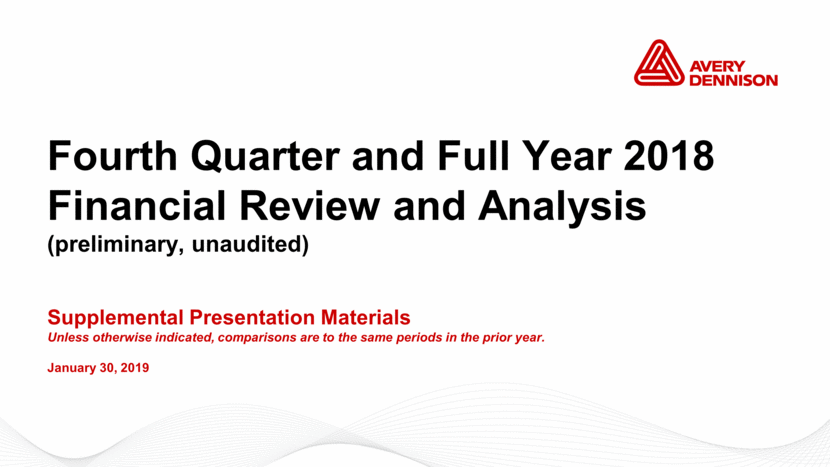
Safe Harbor Statement Certain statements contained in this document are "forward-looking statements" intended to qualify for the safe harbor from liability established by the Private Securities Litigation Reform Act of 1995. These forward-looking statements, and financial or other business targets, are subject to certain risks and uncertainties. Actual results and trends may differ materially from historical or anticipated results depending on a variety of factors, including but are not limited to, risks and uncertainties relating to the following: fluctuations in demand affecting sales to customers; worldwide and local economic conditions; changes in political conditions; changes in governmental laws and regulations; fluctuations in foreign currency exchange rates and other risks associated with foreign operations, including in emerging markets; the financial condition and inventory strategies of customers; changes in customer preferences; fluctuations in cost and availability of raw materials; our ability to generate sustained productivity improvement; our ability to achieve and sustain targeted cost reductions; the impact of competitive products and pricing; loss of significant contracts or customers; collection of receivables from customers; selling prices; business mix shift; execution and integration of acquisitions; timely development and market acceptance of new products, including sustainable or sustainably-sourced products; investment in development activities and new production facilities; amounts of future dividends and share repurchases; customer and supplier concentrations; successful implementation of new manufacturing technologies and installation of manufacturing equipment; disruptions in information technology systems, including cyber-attacks or other intrusions to network security; successful installation of new or upgraded information technology systems; data security breaches; volatility of financial markets; impairment of capitalized assets, including goodwill and other intangibles; credit risks; our ability to obtain adequate financing arrangements and maintain access to capital; fluctuations in interest and tax rates; changes in tax laws and regulations, including the Tax Cuts and Jobs Act (“TCJA”), and uncertainties associated with interpretations of such laws and regulations; outcome of tax audits; fluctuations in pension, insurance, and employee benefit costs, including risks related to the termination of our U.S. pension plan; the impact of legal and regulatory proceedings, including with respect to environmental, health and safety; protection and infringement of intellectual property; the impact of epidemiological events on the economy and our customers and suppliers; acts of war, terrorism, and natural disasters; and other factors. We believe that the most significant risk factors that could affect our financial performance in the near-term include: (1) the impacts of global economic conditions and political uncertainty on underlying demand for our products and foreign currency fluctuations; (2) the degree to which higher costs can be offset with productivity measures and/or passed on to customers through selling price increases, without a significant loss of volume; (3) competitors' actions, including pricing, expansion in key markets, and product offerings; and (4) the execution and integration of acquisitions. For a more detailed discussion of these and other factors, see “Risk Factors” and “Management’s Discussion and Analysis of Results of Operations and Financial Condition” in our 2017 Form 10-K, filed with the Securities and Exchange Commission on February 21, 2018, and subsequent quarterly reports on Form 10-Q. The forward-looking statements included in this document are made only as of the date of this document, and we undertake no obligation to update these statements to reflect subsequent events or circumstances, other than as may be required by law.

Use of Non-GAAP Financial Measures This presentation contains certain non-GAAP financial measures as defined by SEC rules. We report our financial results in conformity with accounting principles generally accepted in the United States of America, or GAAP, and also communicate with investors using certain non-GAAP financial measures. These non-GAAP financial measures are not in accordance with, nor are they a substitute for or superior to, the comparable GAAP financial measures. These non-GAAP financial measures are intended to supplement presentation of our financial results that are prepared in accordance with GAAP. Based upon feedback from investors and financial analysts, we believe that the supplemental non-GAAP financial measures we provide are useful to their assessment of our performance and operating trends, as well as liquidity. In accordance with Regulations G and S-K, reconciliations of non-GAAP financial measures to the most directly comparable GAAP financial measures, including limitations associated with these non-GAAP financial measures, are provided in the financial schedules accompanying the earnings news release for the quarter (see Attachments A-4 through A-8 to news release dated January 30, 2019). Our non-GAAP financial measures exclude the impact of certain events, activities or strategic decisions. The accounting effects of these events, activities or decisions, which are included in the GAAP financial measures, may make it difficult to assess our underlying performance in a single period. By excluding the accounting effects, both positive or negative, of certain items (e.g., restructuring charges, legal settlements, certain effects of strategic transactions and related costs, losses from debt extinguishments, gains or losses from curtailment or settlement of pension obligations, gains or losses on sales of certain assets, and other items), we believe that we are providing meaningful supplemental information that facilitates an understanding of our core operating results and liquidity measures. These non-GAAP financial measures are used internally to evaluate trends in our underlying performance, as well as to facilitate comparison to the results of competitors for a single period. While some of the items we exclude from GAAP financial measures recur, they tend to be disparate in amount, frequency, or timing. We use the following non-GAAP financial measures in this presentation: • Sales change ex. currency refers to the increase or decrease in sales excluding the estimated impact of foreign currency translation and currency adjustment for transitional reporting of highly inflationary economies (Argentina). The estimated impact of foreign currency translation is calculated on a constant currency basis, with prior period results translated at current period average exchange rates to exclude the effect of currency fluctuations. • Organic sales change refers to sales change ex. currency, excluding the estimated impact of product line exits, acquisitions and divestitures, and, where applicable, the extra week in our fiscal year. We believe that sales change ex. currency and organic sales change assist investors in evaluating the sales change from the ongoing activities of our businesses and enhance their ability to evaluate our results from period to period. • Adjusted operating income refers to income before taxes, interest expense, other non-operating expense, and other expense, net. • Adjusted operating margin refers to adjusted operating income as a percentage of sales. • Adjusted tax rate refers to the full-year GAAP tax rate, adjusted to exclude certain unusual or infrequent events that are expected to significantly impact the GAAP tax rate, such as completion of our 2017 TCJA provisional estimate, impacts related to our U.S. pension plan termination, and the effects of discrete tax planning actions. • Adjusted net income refers to income before taxes, tax-effected at the adjusted tax rate, and adjusted for tax-effected restructuring charges and other items. • Adjusted net income per common share, assuming dilution (adjusted EPS) refers to adjusted net income divided by weighted average number of common shares outstanding, assuming dilution. We believe that adjusted operating margin, adjusted net income, and adjusted EPS assist investors in understanding our core operating trends and comparing our results with those of our competitors. • Adjusted EBITDA refers to income before taxes adjusted for interest expense, other non-operating expense, depreciation and amortization, excluding restructuring charges and other items. • Net debt to adjusted EBITDA ratio refers to total debt (including capital leases) less cash and cash equivalents, divided by adjusted EBITDA. We believe that the net debt to adjusted EBITDA ratio assists investors in assessing our leverage position. • Return on total capital refers to income from continuing operations excluding the expense and tax benefit of debt financing divided by the average of beginning and ending invested capital. Adjusted ROTC refers to ROTC adjusted for the impact of the TCJA and 2018 pension plan settlements. We believe that ROTC and adjusted ROTC assist investors in understanding our ability to generate returns from our capital. • Free cash flow refers to cash flow provided by operating activities, less payments for property, plant and equipment, software and other deferred charges, plus proceeds from sales of property, plant and equipment, plus (minus) net proceeds from sales (purchases) of investments and proceeds from insurance. Free cash flow is also adjusted for the cash contributions related to the termination of our U.S. pension plan. We believe that free cash flow assists investors by showing the amount of cash we have available for debt reductions, dividends, share repurchases, and acquisitions. This document has been furnished (not filed) on Form 8-K with the SEC and may be found on our website at www.investors.averydennison.com.
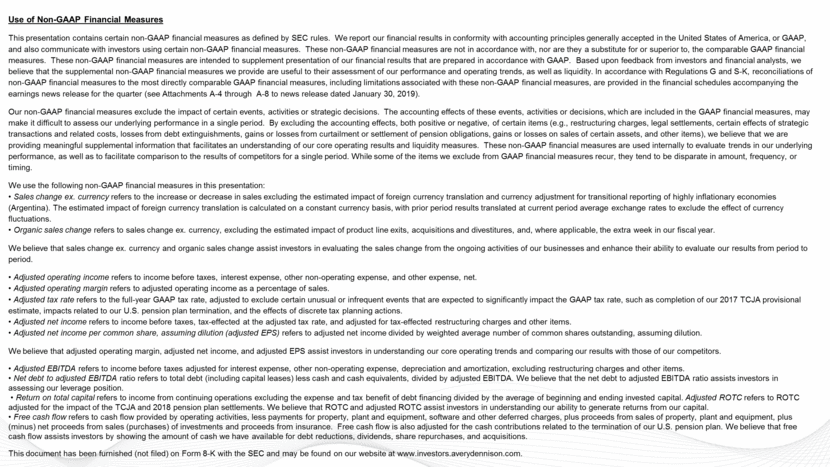
Seventh consecutive year of strong top-line growth, margin expansion, and double-digit adjusted EPS growth Met or exceeded five-year targets through 2018; on track to achieve 2021 goals Sales up 8.2%; organic growth of 5.5%, led by high value categories and emerging markets Continued to deliver strong margins while facing significant raw material inflation Reported operating margin of 10.0%, down 10 bps reflecting higher restructuring charges Adjusted operating margin up 30 bps to 11.0% Reported EPS of $5.28, up 69% (YOY trend impacted by P/Y tax reform and 2018 pension termination) Adjusted EPS (non-GAAP) of $6.06, up 21% ROTC (non-GAAP) of 19%; free cash flow of $429 mil., with higher capital investment Disciplined execution of capital allocation strategy Accelerated share buyback in second half (FY shareholder distributions of $568 mil., ~2X prior year)
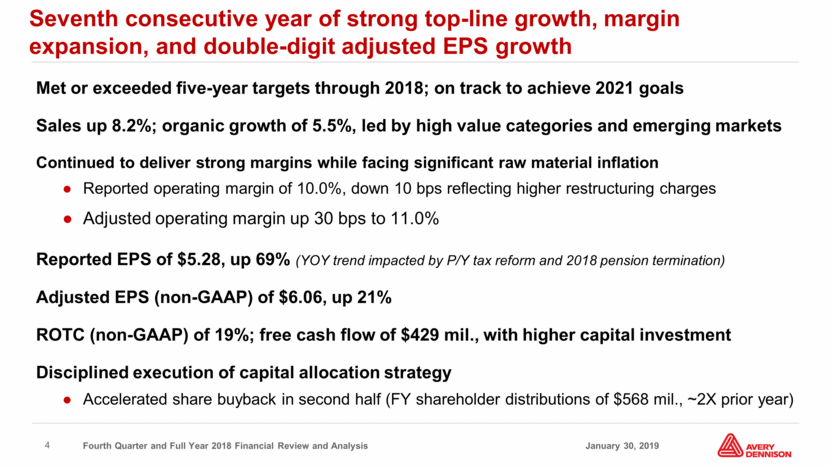
Full Year 2018 Segment Overview and 2019 Outlook LGM delivered another year of strong top-line growth, while maintaining strong operating margins despite significant raw material inflation Continued above-average growth from emerging markets and high value categories, with solid growth in the base RBIS again delivered strong top-line growth and significant margin expansion Accelerated growth from RFID and continued share gain in the base IHM making progress with turnaround during challenging year; remain confident in ability to achieve 2021 targets Targeting continued advancement toward long-term goals in 2019 Organic top-line growth of ~4%, reflecting uncertain economic environment Reported EPS of $2.70 to $2.95; adjusted EPS of $6.45 to $6.70 Midpoint of adj. EPS guidance up ~9%, or ~12% before the impact of currency translation
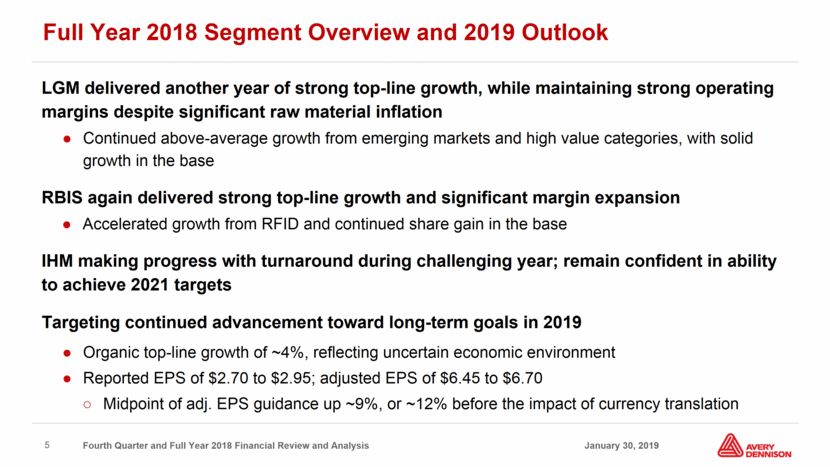
Full Year Segment Sales and Margin Analysis FY18 Reported Ex. Currency Organic Sales Change: Label and Graphic Materials 7.5% 5.7% 5.5% Retail Branding and Information Solutions 6.7% 6.9% 6.9% Industrial and Healthcare Materials 17.6% 16.1% 1.4% Total Company 8.2% 6.9% 5.5% Reported Adjusted (Non-GAAP) FY18 FY17 FY18 FY17 Operating Margin: Label and Graphic Materials 11.7% 12.8% 13.0% 13.1% Retail Branding and Information Solutions 10.6% 8.4% 11.3% 9.6% Industrial and Healthcare Materials 9.1% 8.9% 8.9% 9.5% Total Company 10.0% 10.1% 11.0% 10.7%
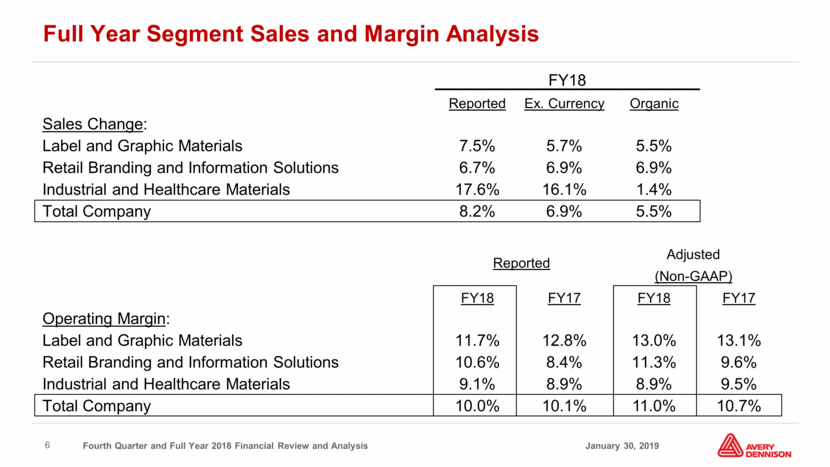
Achieved our five-year targets through 2018 4%–5% Organic Sales Growth(1) 9%–10% (up ~2 pts vs. 2013) Operating Margin in 2018 16%+ Return on Total Capital (ROTC) in 2018 12%–15%+ Adjusted EPS Growth(1) 1.7x to 2.0x Net Debt to Adjusted EBITDA in 2018 4.3% 2014 – 2018 TARGETS 10.0% Adj.(2): 11.0% 18% 1.8x at Y/E 2014 – 2018 RESULTS (1) Reflects five-year compound annual growth rates, with 2013 as the base period (2) Excluding restructuring charges and other items 19%
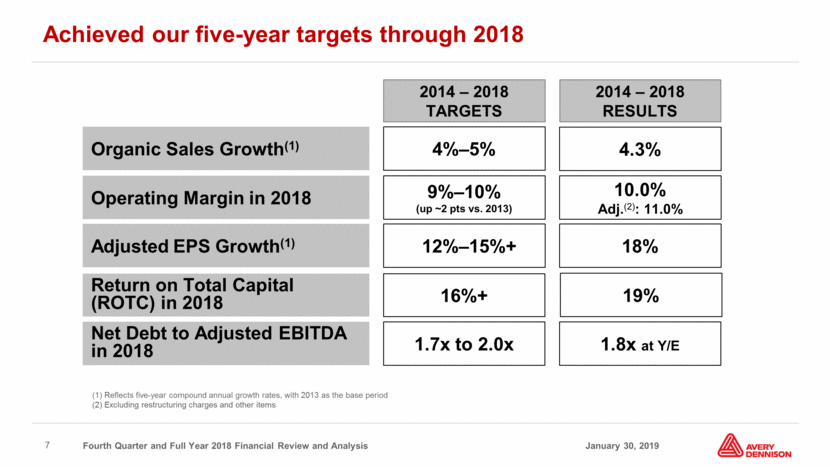
Sales Growth Adjusted EPS Growth Return on Total Capital (ROTC) 4.8% Organic(3) 7.5% Ex. Currency(3) 2017 – 2018 RESULTS (1) Reflects five-year compound annual growth rate, with 2016 as the base period (2) Impact of closed acquisitions as of 3/8/2017 is approximately 1 point of growth (3) Reflects two-year compound annual growth rate, with 2016 as the base period (4) Excluding restructuring charges and other items (5) Reflects adjustment of target (from a range of 1.7x to 2.0x) in July 2018, following decision to fully fund and terminate our U.S. pension plan. See Form 8-K filed July 11, 2018. 4%+ Organic(1) 5%+ Ex. Currency(1,2) 10%+(1) 17%+ in 2021 2017 – 2021 TARGETS Operating Margin 10.0% in 2018 Adj(4): 11.0% in 2018 11%+ in 2021 Net Debt to Adjusted EBITDA 1.8x at Y/E 2018 2.3x to 2.6x(5) 23%(3) 19% in 2018 On track to achieve our long-term targets through 2021
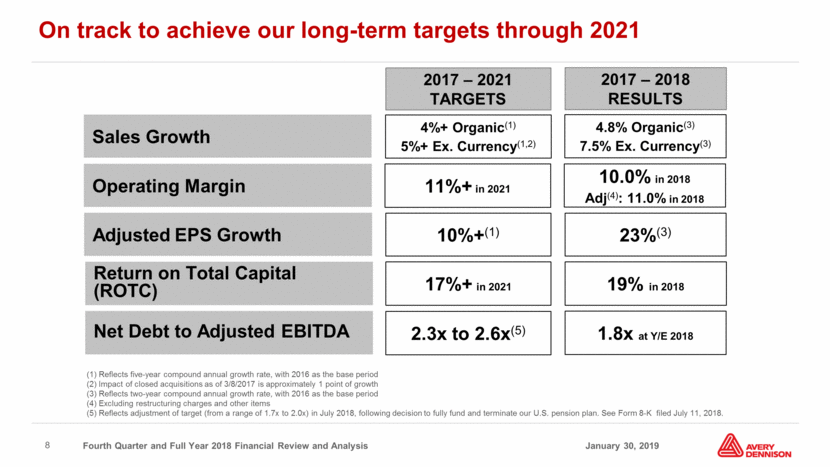
Maintaining disciplined approach to capital allocation ACTUAL 2017 + 2018

Fourth Quarter Overview Fourth quarter reported EPS of $1.11 Reported EPS trend vs. prior year not meaningful due to a number of factors, including P/Y tax reform and 2018 pension settlement charges Adj. EPS of $1.52, up 14% driven by sales growth and margin expansion Reported sales of $1.77 bil., up 1.9% compared to prior year Organic sales growth (non-GAAP) of 4.8% Reported operating margin increased 90 bps to 11.0% as the benefits from higher volume/mix and productivity were partially offset by higher employee-related costs Adjusted operating margin increased 50 bps to 11.1%, with LGM’s margin rebounding from Q3 level, as expected Accelerated share repurchase to $218 mil. in the quarter ($393 mil. for the year)
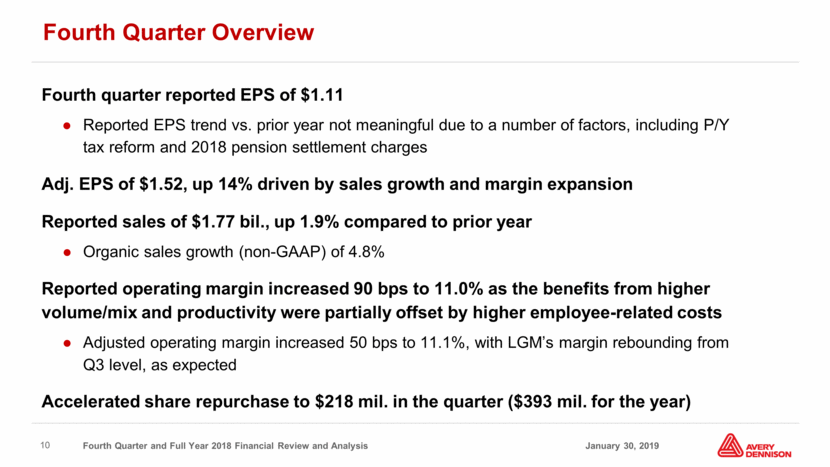
Sales Trend Analysis * Totals may not sum due to rounding. 4Q17 1Q18 2Q18 3Q18 4Q18 FY18 Reported Sales Change 11.9% 13.0% 14.0% 4.8% 1.9% 8.2% Organic Sales Change 4.7% 3.4% 7.5% 6.1% 4.8% 5.5% Acquisitions 4.4% 3.3% 2.5% 0.0% 0.0% 1.4% Sales Change Ex. Currency* 9.1% 6.8% 10.0% 6.1% 4.8% 6.9% Currency Translation 2.8% 6.2% 4.0% -1.3% -2.9% 1.4% Reported Sales Change* 11.9% 13.0% 14.0% 4.8% 1.9% 8.2%

Fourth Quarter Segment Sales and Margin Analysis 4Q18 Reported Ex. Currency Organic Sales Change: Label and Graphic Materials 1.7% 4.7% 4.7% Retail Branding and Information Solutions 4.2% 6.9% 6.9% Industrial and Healthcare Materials (1.6%) 0.7% 0.7% Total Company 1.9% 4.8% 4.8% Reported Adjusted (Non-GAAP) 4Q18 4Q17 4Q18 4Q17 Operating Margin: Label and Graphic Materials 12.7% 12.1% 12.9% 12.5% Retail Branding and Information Solutions 11.6% 11.1% 12.2% 12.1% Industrial and Healthcare Materials 10.3% 7.6% 9.6% 7.9% Total Company 11.0% 10.1% 11.1% 10.6%

LABEL AND GRAPHIC MATERIALS Reported sales of $1.2 bil., up 1.7% Sales up 4.7% on organic basis, largely driven by pricing actions Label and Packaging Materials sales up mid-single digits on organic basis Combined Graphics and Reflective Solutions up mid-single digits on organic basis Reported operating margin increased 60 bps to 12.7% as the benefits of productivity, increased volume/mix, and the net impact of pricing and raw material costs more than offset higher employee-related expense and transition costs associated with the European restructuring plan Adjusted operating margin increased 40 bps to 12.9% RETAIL BRANDING AND INFORMATION SOLUTIONS Reported sales of $412 mil., up 4.2% Sales up 6.9% on organic basis, driven by strength in both the base business and RFID Reported operating margin increased 50 bps to 11.6%, as restructuring charges declined and the benefits from increased volume and productivity more than offset higher employee-related costs and growth-related investments Adjusted operating margin increased 10 bps to 12.2% Fourth Quarter Segment Overview
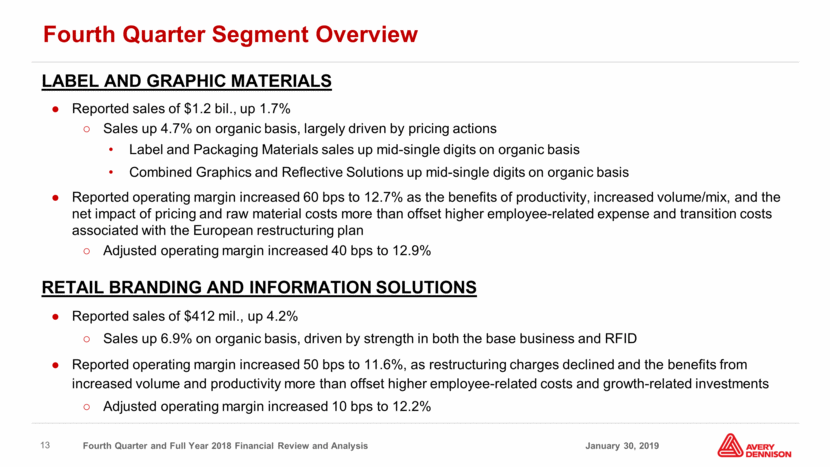
INDUSTRIAL AND HEALTHCARE MATERIALS Reported sales of $175 mil., down 1.6%; sales up 0.7% on organic basis Mid-single digit organic growth for healthcare globally and for industrial categories in North America and Europe Industrial products for the North Asia market (~1% of total company sales) declined due to drop in auto production Reported operating margin increased 270 bps to 10.3%, driven by productivity improvement initiatives and acquisition-related items Adjusted operating margin increased 170 bps to 9.6% Fourth Quarter Segment Overview (cont.)
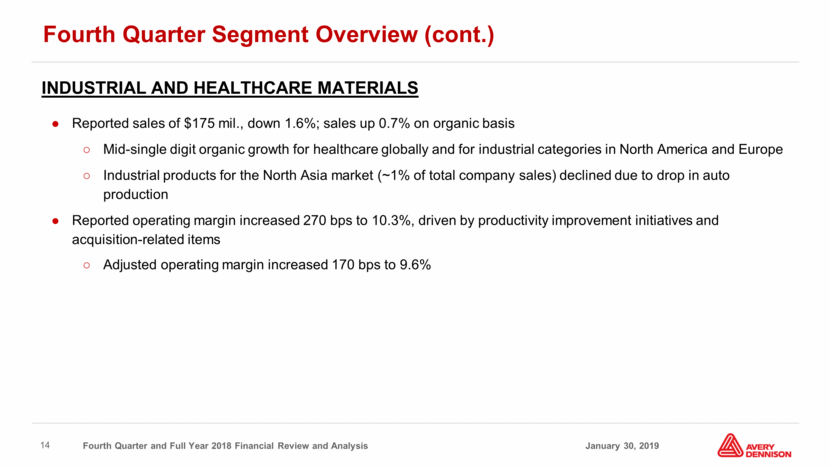
2019 EPS Guidance Add Back: Est. pension settlement charge in Q1 Est. restructuring costs and other items Adjusted EPS (non-GAAP) Reported EPS $2.70 – $2.95 $6.45 – $6.70 Reported sales growth of ~1.5%, including ~2.5 pt headwind from currency translation at recent rates Organic sales change of ~4% Currency translation headwind to operating income of ~$25 mil., assuming recent rates Incremental savings of ~$35 mil. from restructuring actions, net of transition costs Adjusted tax rate in the mid-twenty percent range Interest expense of $75 mil. to $80 mil. Fixed and IT capital spend of $275 mil. to $285 mil. Average shares outstanding (assuming dilution) of 84 mil. to 85 mil. Adjusted earnings growth weighted to the back half of the year due to timing of currency translation headwinds and restructuring actions Contributing Factors to 2019 Results ~$0.20 ~$3.55
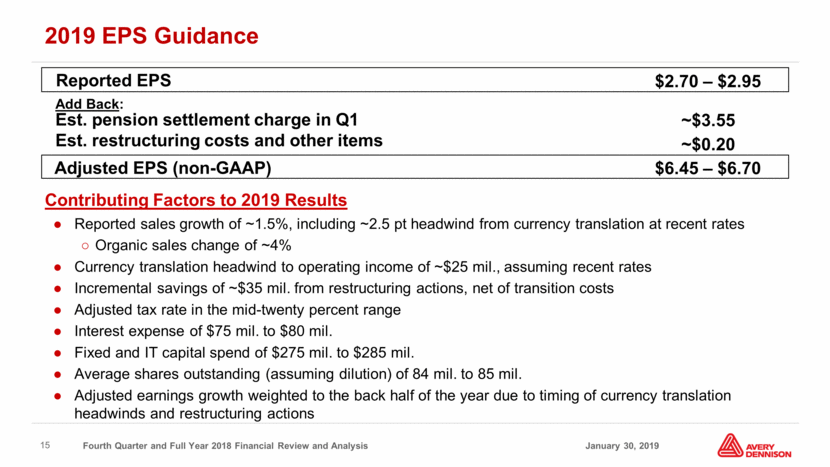
Appendix: Reconciliation of Financial Measures from GAAP to Non-GAAP
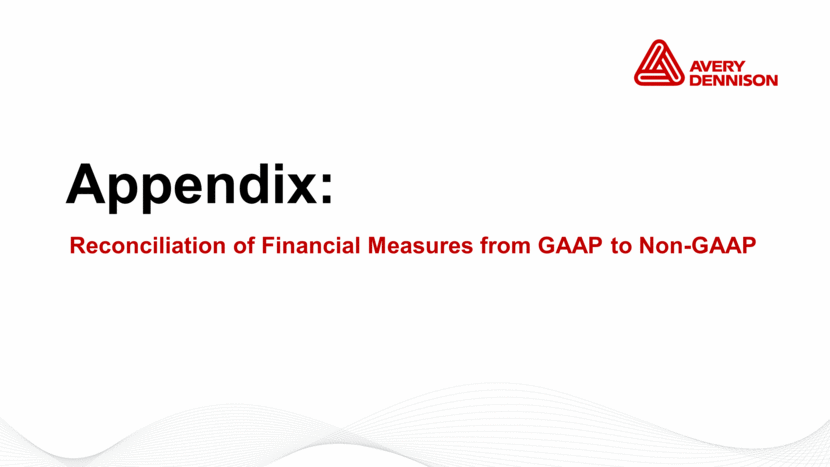
Organic Sales Change – Avery Dennison (1) Totals may not sum due to rounding and other factors.
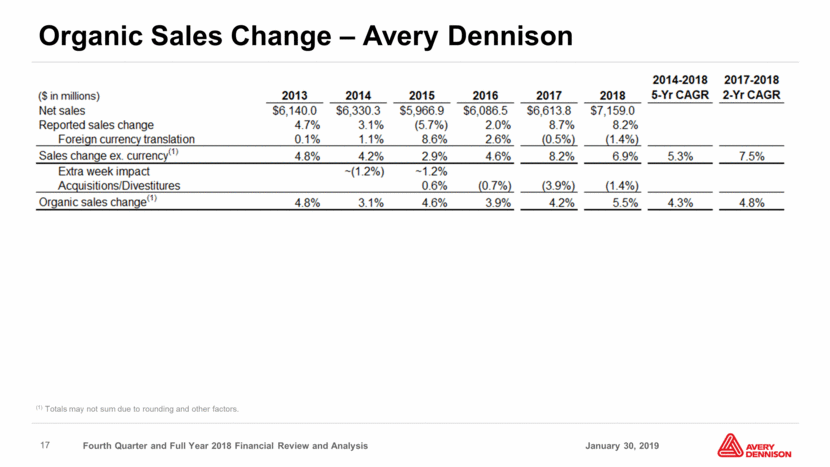
Organic Sales Change by Segment (1) Totals may not sum due to rounding and other factors.
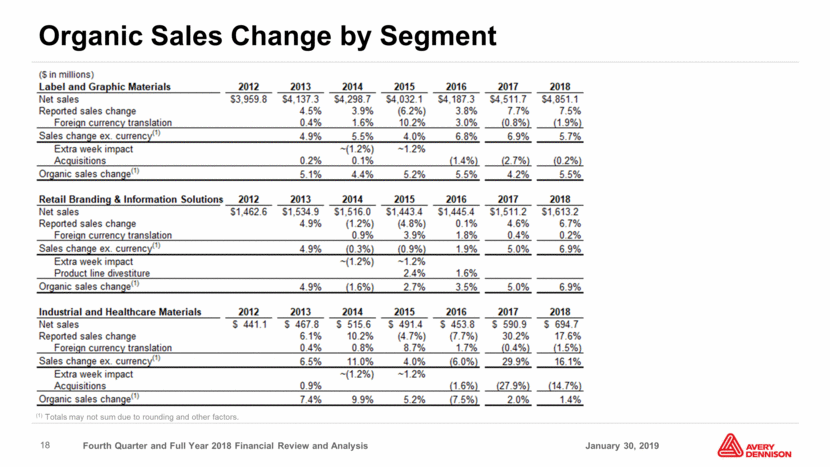
Adjusted Operating Margin – Avery Dennison (1) In the first quarter of 2018, we adopted Accounting Standards Update (ASU) No. 2017-07, Improving the Presentation of Net Periodic Pension Cost and Net Periodic Postretirement Benefit Cost, on a retrospective basis. This ASU requires employers with defined benefit plans to present the components of net periodic benefit cost other than service cost, outside of operating income. Prior year results have been reclassified as required by the guidance. (2) GAAP adjustments for 2013-2015 reflect the previously disclosed impact of the third quarter of 2015 revision to certain benefit plan balances, which had an immaterial impact on the non-GAAP amounts.
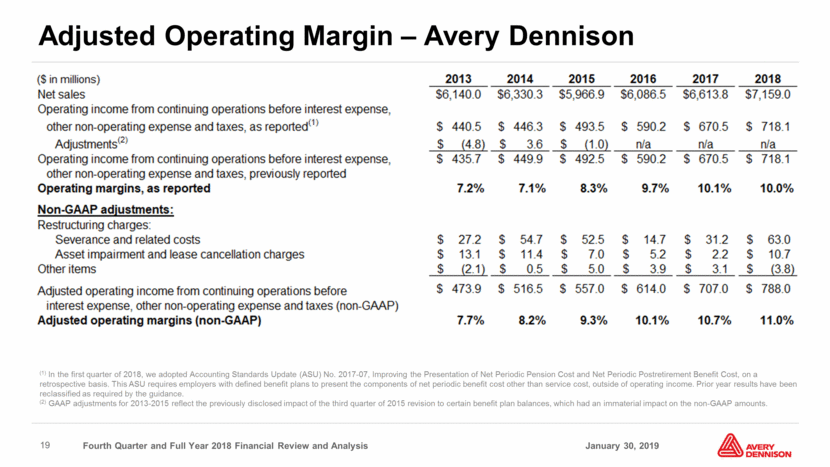
Adjusted Operating Margin – LGM (1) In the first quarter of 2018, we adopted Accounting Standards Update (ASU) No. 2017-07, Improving the Presentation of Net Periodic Pension Cost and Net Periodic Postretirement Benefit Cost, on a retrospective basis. This ASU requires employers with defined benefit plans to present the components of net periodic benefit cost other than service cost, outside of operating income. Prior year results have been reclassified as required by the guidance.
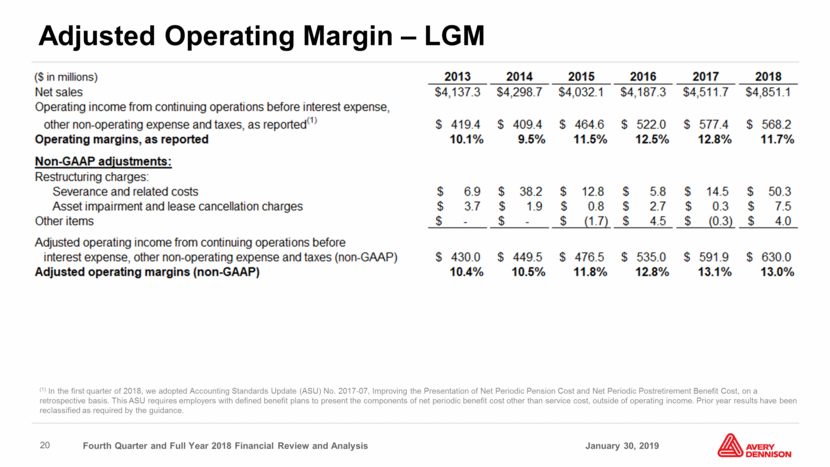
Adjusted Operating Margin – RBIS (1) In the first quarter of 2018, we adopted Accounting Standards Update (ASU) No. 2017-07, Improving the Presentation of Net Periodic Pension Cost and Net Periodic Postretirement Benefit Cost, on a retrospective basis. This ASU requires employers with defined benefit plans to present the components of net periodic benefit cost other than service cost, outside of operating income. Prior year results have been reclassified as required by the guidance.

Adjusted Operating Margin – IHM (1) In the first quarter of 2018, we adopted Accounting Standards Update (ASU) No. 2017-07, Improving the Presentation of Net Periodic Pension Cost and Net Periodic Postretirement Benefit Cost, on a retrospective basis. This ASU requires employers with defined benefit plans to present the components of net periodic benefit cost other than service cost, outside of operating income. Prior year results have been reclassified as required by the guidance.
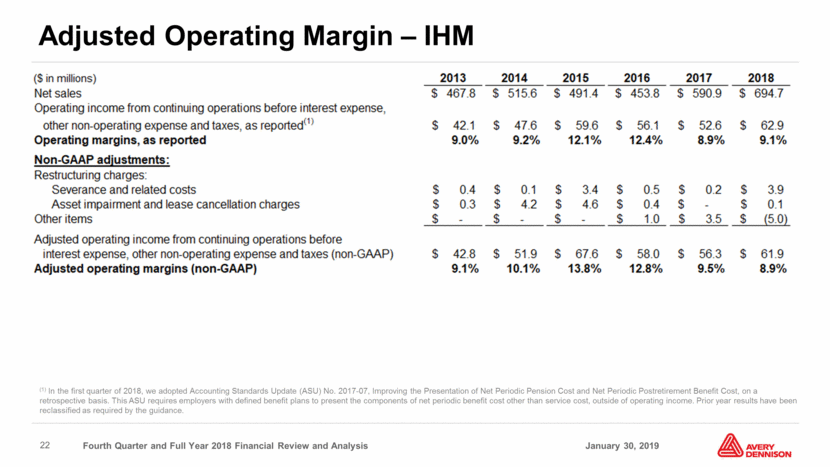
Adjusted Net Income (1) GAAP adjustments for 2013-2015 reflect the previously disclosed impact of the third quarter of 2015 revision to certain benefit plan balances, which had an immaterial impact on the non-GAAP amounts. (2) Includes restructuring charges, Argentine peso remeasurement transition loss, other restructuring-related charge, transaction costs, reversal of acquisition-related contingent consideration, and net gain on sales of assets. (3) Tax benefits from the deduction of the third quarter U.S. pension contributions on the company's 2017 U.S. income tax return. (4) In the fourth quarter of 2018, we finalized our provisional estimate as defined under SEC Staff Accounting Bulletin No. 118 related to the U.S. Tax Cuts and Jobs Act ("TCJA") of 2017. The adjusted tax rate was 25% for the three and twelve months ended Dec. 29, 2018, and 28% for the three and twelve months ended Dec. 30, 2017.
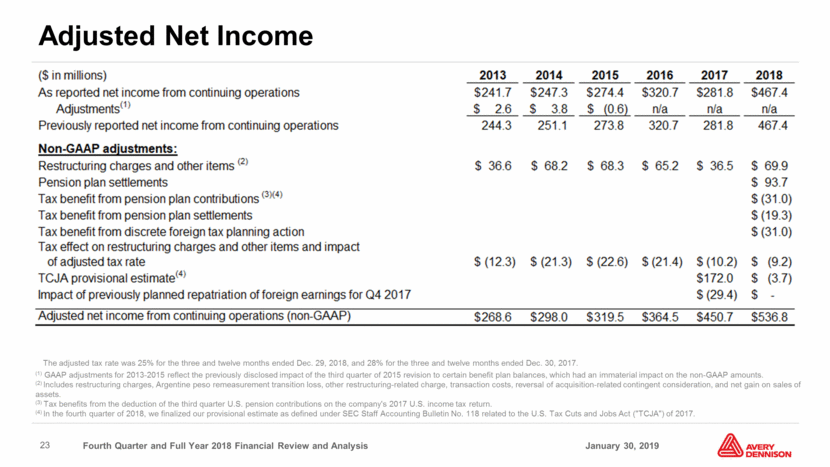
Adjusted EPS (1) GAAP adjustments for 2013-2015 reflect the previously disclosed impact of the third quarter of 2015 revision to certain benefit plan balances, which had an immaterial impact on the non-GAAP amounts. (2) Includes restructuring charges, Argentine peso remeasurement transition loss, other restructuring-related charge, transaction costs, reversal of acquisition-related contingent consideration, and net gain on sales of assets. (3) In the fourth quarter of 2018, we finalized our provisional estimate as defined under SEC Staff Accounting Bulletin No. 118 related to the U.S. Tax Cuts and Jobs Act ("TCJA") of 2017. The adjusted tax rate was 25% for the three and twelve months ended Dec. 29, 2018, and 28% for the three and twelve months ended Dec. 30, 2017.
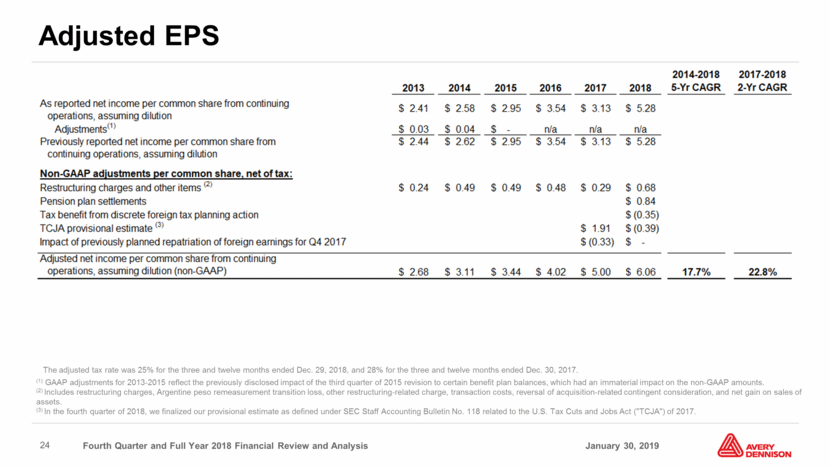
Free Cash Flow (1) In the first quarter of 2018, we adopted ASU No. 2016-15, Classification of Certain Cash Receipts and Cash Payments, on a retrospective basis. This ASU reduces the diversity in the presentation and classification of certain cash receipts and cash payments in the statement of cash flows. Prior year results have been reclassified as required by the ASU.
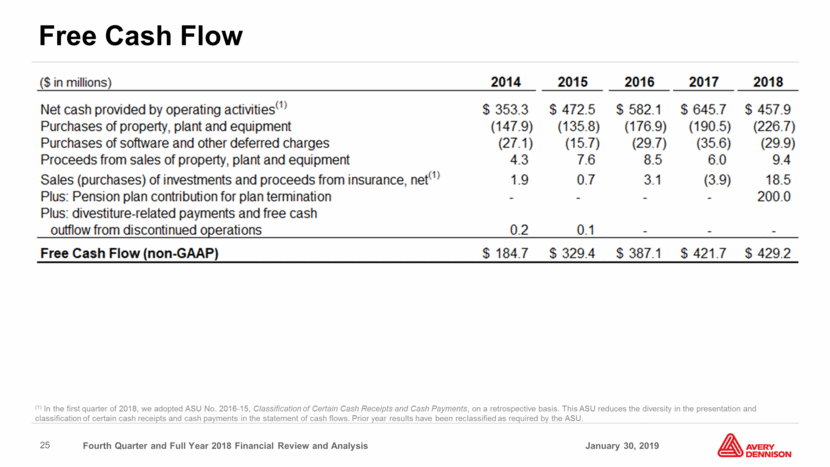
Return on Total Capital (ROTC) (1) "Provision for income taxes" for the fourth quarter of 2017 includes the estimated impact of TCJA enacted in the U.S. on December 22, 2017. In the fourth quarter of 2018, we finalized our provisional estimate as defined under SEC Staff Accounting Bulletin No. 118 related to TCJA. (2) Tax benefits resulting from the deduction of the third quarter 2018 pension contributions on the company’s 2017 U.S. income tax return.

Net Debt to Adjusted EBITDA (1) In the first quarter of 2018, we adopted Accounting Standards Update (ASU) No. 2017-07, Improving the Presentation of Net Periodic Pension Cost and Net Periodic Postretirement Benefit Cost, on a retrospective basis. This ASU requires employers with defined benefit plans to present the components of net periodic benefit cost other than service cost, outside of operating income. Prior year results have been reclassified as required by the guidance.
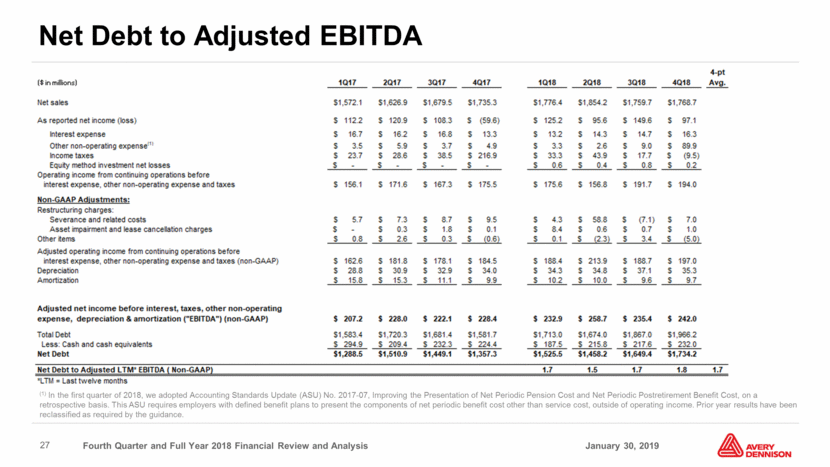
[LOGO]

